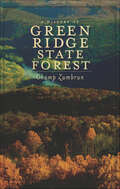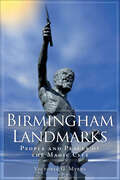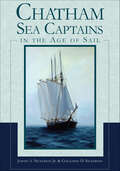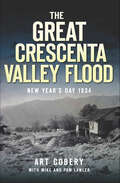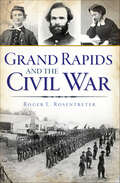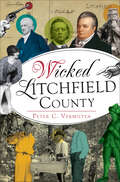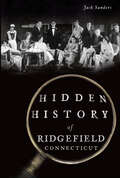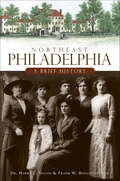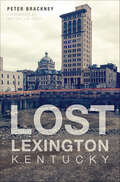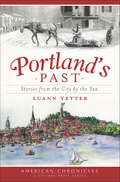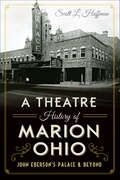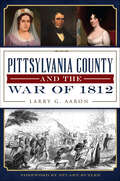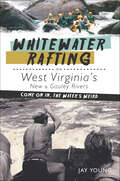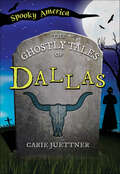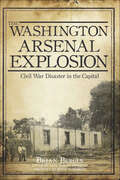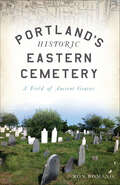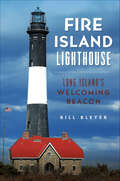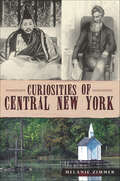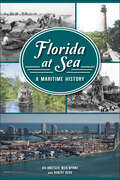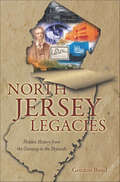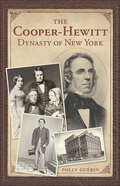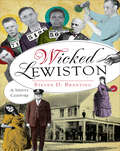- Table View
- List View
A History of Green Ridge State Forest
by Champ ZumbrunJoin former forest manager Champ Zumbrun as he traverses hidden trails to tell the remarkable story of Green Ridge State Forest.Green Ridge State Forest is a haven of calm and natural beauty among the Appalachians of western Maryland. This land was once the frontier of the nation, and trailblazers such as Thomas Cresap and George Washington were among the first Europeans to discover its wonders: the swift Potomac, the flowering dogwood and pine in the mountain reaches and the nighttime calls of the bobcat and the barred owl. The vision and stewardship of people like forester Fred W. Besley preserved the forest for future generations of hikers, explorers and families. Join former forest manager Champ Zumbrun as he traverses hidden trails to tell the remarkable story of Green Ridge State Forest.
Lost Rochester, Minnesota (Lost)
by Amy Jo HahnRochester is synonymous with one of its most famous landmarks, the Mayo Clinic, but there's so much more to the Med City. It began as a frontier town, struggling to make its mark in a sparsely populated wilderness. By the late nineteenth century, Rochester had expanded into a vibrant city, rich with business, educational and cultural opportunities. Rediscover the Dubuque Trail and the beautiful summer lake retreats, along with the Cook Hotel, the Central Fire Station and more. Author Amy Jo Hahn uncovers the lost beginnings of Rochester and brings the stories of this unique place to life.
Birmingham Landmarks: People and Places of the Magic City (Landmarks)
by Victoria MyersThough the landscape has certainly changed, many of Birmingham�s early landmarks�testaments to the steelworkers who built the city after the Civil War, as well as those who have since prospered here�remain. In Birmingham Landmarks, Alabama native Victoria Myers explores the Magic City�s most prominent industrial and cultural features. Step back in time to discover Rickwood Field, one of America�s oldest baseball parks, and the Carver Theater, the only venue that allowed African Americans to view first-run movies before the civil rights movement. Find out why Birmingham is known as the Pittsburgh of the South at Sloss Furnaces and learn the secrets of Vulcan, who was commissioned for the 1904 World�s Fair and has become one of the state�s most recognizable monuments.
Chatham Sea Captains in the Age of Sail
by Geraldine D. Nickerson Joseph A. Nickerson Jr.Chatham Sea Captains in the Age of Sail chronicles the lives and adventures of twenty-five men who traveled the seas from the eighteenth through the twentieth century. These were extraordinary men�masters of navigation who charted paths from the Cape to the Far East with their regal clipper ships; deep-sea fishermen whose fearless spirit drove them to the Grand Banks and Newfoundland in the quest for their catch; and coastal captains who skirted America�s eastern seaboard in pursuit of trade. Spurred on by the Industrial Revolution�s demands, these mariners continued their pelagic exploration while pirates, privateers and Confederate raiders tested their mettle. The sea was both foe and ally. To meet the foe was the challenge; to sail her waters and return home as true masters was the force that drove these men to excellence.
The Great Crescenta Valley Flood: New Year's Day 1934 (Disaster)
by Art CoberyAs Crescenta Valley residents gathered to ring in the 1934 New Year, a cloudburst broke over Southern California's San Gabriel Mountains, unleashing a deluge on mountainsides denuded by recent fires. A roaring wall of rocks, mud and water crashed down the canyons, uprooting trees, tossing boulders and automobiles like toys and carving a path of destruction. Using painstaking research and heart-rending firsthand accounts, historian Art Cobery paints a picture of survival and redemption in the face of natural disaster, including the heroic efforts of eleven-year-old Marcie Warfield to save her father and younger brother, the devastating debris flow that claimed the lives of refugees and aid workers at the American Legion Hall and the selfless acts of neighbors caught in the storm of events.
Grand Rapids and the Civil War (Civil War Series)
by Roger L. RosentreterGrand Rapids responded to President Abraham Lincoln's call for troops with passionate swiftness. Kent County men fought stubbornly on memorable battlefields like First Bull Run, Stones River and Gettysburg, as well as obscure places like Boonville, La Vergne and Mossy Creek. An affinity for cavalry earned Grand Rapids the moniker "Michigan's Horse Soldier City," while Valley City engineers designed and constructed spectacular railroad bridges throughout the South. Back home, the soldiers' mothers, wives and sisters faced the conflict's many challenges with patriotic doggedness. Dr. Roger L. Rosentreter chronicles how Grand Rapids citizens responded to wartime trials and tribulations while helping the North save the Union and end slavery.
Gamecock Glory: The University of South Carolina Baseball Team's Journey to the 2010 NCAA Championship (Sports)
by Travis HaneyAfter more than one hundred years of craving a champion, the University of South Carolina finally has one. The 2010 Gamecock baseball team won six consecutive games over eight summer nights to take the College World Series and lay claim to the school's first major national championship. From dancing around in a dark locker room to singing "Silent Night"? on the team bus after every victory in Omaha, these Gamecocks were as fun-loving as they were talented. And they did it all in the name of one special boy, seven-year-old Bayler Teal. Bayler passed away before he could see his beloved Gamecocks triumph, but the team's victory is a tribute to their number one fan. Join the Post and Courier's Travis Haney as he recounts this incredible team's historic season.
Wicked Litchfield County (Wicked)
by Peter C. VermilyeaThieves, rumrunners and rapscallions all color the unsavory side of Litchfield County history. Townspeople accused women of witchcraft simply for not bearing enough children in the early days of the region. During the eighteenth and nineteenth centuries, Owen Sullivan and William Stuart took advantage of the county's isolated stretches and a currency shortage to build counterfeiting empires. In 1780, Barnett Davenport's brutal actions earned him infamy as the nation's first mass murderer. Small-time speakeasies slowly took hold, and the omnipresence of alcohol-fueled crime led to the birth of the nationwide prohibition movement. Local historian Peter C. Vermilyea explores these and other devilish tales from the seedier history of Litchfield County.
Hidden History of Ridgefield, Connecticut (Hidden History)
by Jack SandersTime nearly erased many astounding tales and unexpected anecdotes from Ridgefield's history. Its colorful characters include a widow who built a landmark Manhattan hotel, her neighbor who invented one of the first "helicopters" and a CIA operative who helped one thousand Americans flee Saigon at the end of the Vietnam War. Lesser known are the stories of the Ridgefield artists who gave the world Superman and Lowly Worm and brought the Wild West to life. One local writer helped make Hawthorne famous, while another penned thousands of hymns still sung around the globe. Join retired newspaper editor Jack Sanders as he uncovers nearly forgotten people and moments of Ridgefield's past.
Rio Grande Sniper Killings, The: Caught in the Sights of a Drug Conspiracy (True Crime)
by John PrimomoUntangle the complex conspiracy that led to the tragic deaths of Charlotte Kay Elliott and Kevin Edwin Frase on the banks of the Rio Grande. On the night of July 13, 1980, a hitman fired a high-powered rifle into the crowd at Pepe's On the River, an outdoor bar in Mission, Texas. He missed his target, a witness in the Loop 360 drug case, but killed two young bystanders. While state court prosecutions for capital murder inexplicably faltered, a federal court gave the assassin a life sentence for attempted murder of a grand jury witness. A member of the judge's staff who was present throughout the trial, author John W. Primomo revisits the dramatic twists and turns surrounding this murder on the Rio Grande.
Northeast Philadelphia: A Brief History (Brief History)
by Frank W. Hollingsworth Dr. Harry SilcoxNortheast Philadelphia chronicles this area's history of transformation, from scattered communities to an urban center.Before the Consolidation Act of 1854 more than tripled the former capital's population, Northeast Philadelphia was a scattered group of pastoral communities just beyond the city limits. Holmesburg, Somerton and other small villages initially struggled but ultimately triumphed in their transition from rural townships to a bustling urban center. Dr. Harry C. Silcox has collaborated with Frank W. Hollingsworth to chart this fascinating evolution, from the demise of the family farm to neighbors uniting on the homefront during World War II. With such lively characters as Mary Disston, the founding mother of Tacony, and tales of the local effort for suffrage, Silcox and Hollingsworth create a brilliant and affectionate portrait of Northeast Philadelphia.
Lost Lexington, Kentucky (Lost)
by Peter BrackneyLexington has dozens of well-restored landmarks, but unfortunately so many more are lost forever.The famous Phoenix Hotel, a longtime stop for weary travelers and politicians alike, has risen from its own ashes numerous times over the past centuries. The works of renowned architect John McMurtry were once numerous around town, but some of the finest examples are gone. The Centrepointe block has been made and unmade so many times that its original tenants are unknown to natives now. Join local blogger, attorney and preservationist Peter Brackney as he explores the intriguing back stories of these hidden Bluegrass treasures.
Portland's Past: Stories from the City by the Sea (American Chronicles)
by Luann YetterHenry Wadsworth Longfellow immortalized Portland, Maine, as the �beautiful town that is seated by the sea.� In this volume, Maine author Luann Yetter presents the stories from its past that not only showcase this exquisiteness but also illuminate its diverse and exciting history. The founding members of the Forest City braved the harsh winters, but not without scandals and struggles. One man raised a navy to fight the Barbary pirates threatening ships that sailed from Casco Bay, and privateers brought rum onboard and ashore. And while one Portlander traded slaves, many others worked the Underground Railroad as staunch antislavery crusaders. Discover Portland from its beginning as uncharted territory through to its development into the quintessential New England city it is today.
A Theatre History of Marion, Ohio: John Eberson's Palace And Beyond (Landmarks)
by Scott L. HoffmanOne of the last remaining atmospheric theatres in the nation, elegant Marion Palace Theatre holds a storied history behind its curtains. From the "Wigwam," the Grand Opera House and Germania Park Pavilion to nickelodeons, vaudeville houses and movie theatres, performance has been an essential part of Marion's history, and the Palace is the city's jewel. Designed by renowned theatre architect John Eberson, the Palace opened its doors in 1928 to packed audiences of over three thousand patrons. Author Scott L. Hoffman delves into the life and work of John Eberson and the forgotten stories of the Palace that include a police gambling raid, the construction of the theatre and the stars who performed for dazzled audiences there.
Pittsylvania County and the War of 1812 (Military)
by Larry G. AaronRural Pittsylvania County and Danville, Virginia, remained far from the fields of conflict during the War of 1812. Yet its sons served valiantly along the Canadian frontier and in the defense of Richmond, Norfolk and Baltimore as British forces plundered villages up and down the Chesapeake Bay. General Andrew Jackson's wife, Rachel, a county native, celebrated the victory at the Battle of New Orleans with him. The homefront endured economic tribulations yet stood faithfully by its soldiers. Author and historian Larry G. Aaron reveals how Pittsylvania County served, suffered and sacrificed during the nation's second war of independence.
Whitewater Rafting on West Virginia's New & Gauley Rivers: Come on In, the Water's Weird (Sports)
by Jay YoungA certain mixture of whimsy and derring-do is required to shove off down (or up) the New or Gauley River with scant protection aside from a helmet, life vest and one�s compatriots. It�s a choice that could be so easily avoided, but that wouldn�t make sense to the proud and colorful characters who have long been shooting these rapids, some of the most popular and treacherous in the country. Here, Jay Young, a raft guide turned writer, leads readers through the local lore and history of the rivers, where�much to the delight of those brave enough to face these rapids�the ordinary almost never occurs.
The Ghostly Tales of Dallas (Spooky America)
by Carie JuettnerGhost stories from Dallas, Texas have never been so creepy, fun, and full of mystery! Welcome to the spooky streets of Dallas! Stay alert! Ghosts lurk around every corner. Even the most unexpected places might be haunted by wandering phantoms. Did you know that the Sammons Center for the Arts is said to have a haunted elevator? Or that sounds of music and laughter sometimes drift up and down the halls of the Adolphus Hotel... even when no one is there? Can you believe the friendly ghost at Catfish Plantation has been known to make coffee for its hosts? Pulled right from history, these ghostly tales will change the way you see Dallas and have you sleeping with the light on!
The Washington Arsenal Explosion: Civil War Disaster in the Capital (Disaster)
by Brian BerginIn 1864, residents of Washington, D.C., mourned together at the largest funeral the district had ever seen. In the midst of the Civil War, the poor Irish neighborhood of the Island lost twenty-one mothers, sisters and daughters. On June 17, dangerous working conditions and a series of unfortunate events led to the deadly explosion of a Federal arsenal at Fort McNair, where the young women made cartridges to assist the war effort. In the wake of the horrific event, a monument was erected at Congressional Cemetery to honor those who were lost. Author Brian Bergin similarly memorializes these women through his book, detailing the poor working conditions, the investigation into the avoidable events leading to the tragedy and the reaction of a community already battered by the Civil War.
Portland’s Historic Eastern Cemetery: A Field of Ancient Graves (Landmarks)
by Ron RomanoA window into the past of Historic Eastern Cemetery, illuminating centuries of Portland's history through the stories of those laid to rest.Eastern Cemetery holds more than 350 years of Portland's rich history. From bank robbers and murdering mutineers to Quakers and war heroes, the lives of those interred offer a window into the past. Within the sacred burial ground rest settlers who struggled with the natives over resources, citizens who had to choose their allegiance to the king or independence and abolitionists fighting for the end of slavery. Author and cemetery guide Ron Romano tells the fascinating tale of this historic landscape, illuminating centuries of Portland's history through the stories of those laid to rest.
Fire Island Lighthouse: Long Island's Welcoming Beacon (Landmarks)
by Bill BleyerThe first Fire Island Lighthouse was constructed in 1826 after numerous shipwrecks along the barrier island. A replacement tower built in 1858 incorporated innovations in lighthouse design such as the Fresnel lens. Vessels anchored offshore, known as lightships, augmented the lighthouse for many years. The Coast Guard shut down the site in 1973. Through the efforts of the Fire Island Lighthouse Preservation Society and the National Park Service, the beautiful structure was meticulously restored and the tower relit in 1986. Along with a selection of wonderful color photographs depicting the grandeur of the lighthouse, author Bill Bleyer charts the history of Long Island's cherished Fire Island Lighthouse.
Curiosities of Central New York
by Melanie ZimmerThe people of Central New York know there's something different--perhaps strange--in the air. Across this vast and often wild region, history and lore are remarkably and markedly unusual. Ancient Iroquois mystical traditions still infuse the landscape with a sense of the otherworldly, and for some, witchcraft was a constant fear throughout the nineteenth century. Monsters and even fairies roam the region, frightening or delighting those who say they have encountered them. Visit the world's smallest church in Oneida and North America's only Tibetan monastery, Namgyal, in Ithaca. Join local folklorist Melanie Zimmer as she explores the curiosities of Central New York.
Florida at Sea: A Maritime History (The History Press)
by Joe Knetsch Robert J. ReddFrom small ports to large ports, from rivers to creeks, from lakes to lagoons, water routes have been essential to Florida's development as a commercial, recreational, agricultural, and cultural entity. With more than 30,000 lakes and ponds and some 1,700 rivers, creeks, and streams, Florida ranks second in the list of wettest states in the USA. Native Americans used the rivers, creeks, and lakes as routes to various locales within the peninsula while harvesting fish and other aquatic edibles to sustain their daily lives. Early European settlers followed suit and supplemented their diets with the bounty from the oceans and fresh water sources. Into statehood, settlers relied on the same sources for food while using fresh water to make the land productive for food and cash crops. By the early decades of the 20th Century, water became a marketable attraction to lure millions of tourists to Florida for recreation and sports. The trend continues today. Join a trio of authors on this look at the immense impact water and maritime activities have played in the development of Florida.
North Jersey Legacies: Hidden History from the Gateway to the Skylnds (Hidden History)
by Gordon BondDid you know that the Dust Bowl hit New Jersey? Twice? How about that a mysterious experiment in "subliminal advertising" was conducted at a Fort Lee, New Jersey movie theater? Or that railroad communication was advanced on a northwest New Jersey railroad line? Or that America first heard about the Russians launch of Sputnik 2 (with a dog onboard) thanks to a Ukrainian refugee in Perth Amboy, New Jersey? Or that prisons could buy a custom electric chair from a Trenton, New Jersey electrician? Or that aviation matured into an industry thanks to Newark Airport? This book is a collection of articles from www.GardenStateLegacy.com, an online quarterly magazine devoted to New Jersey history that the author began in 2008. The Garden State features to some degree even as a footnote in larger historical stories far more often than one might think. It could just be a matter of someone from the state going on to something of historic importance somewhere else; or that by dumb luck something just happened to occur within its borders. New Jersey may be a footnote in these tangential tales, but they are the kind of unexpected connections that makes exploring New Jersey's history so delightful.
The Cooper-Hewitt Dynasty of New York
by Polly GuérinPeter Cooper believed that he owed a debt to the city that had made him a rich man. During the nineteenth century, he made his fortune in industry and his name in politics, and he always felt a strong compulsion to give back to New York. His greatest achievement was the establishment of The Cooper Union, which allowed students from all walks of life to study science and art and is still providing those opportunities today. Cooper instilled this sense of obligation in his children and his business partner and son-in-law, Abram Hewitt. Abram's daughters--remarkable women ahead of their time--fulfilled their grandfather's dream of opening a museum, which became the Cooper-Hewitt National Design Museum, today part of the Smithsonian Institution. Discover this amazing story of wealth and generosity, politics and integrity and family and community that could have only unfolded in New York.
Wicked Lewiston: A Sinful Century (Wicked)
by Steven D. BrantingLewiston boasts a tawdry, scandalous history. In 1872, prostitutes Carlotta Felis and Anna Ream appeared in a survey of Nez Perce County's wealthiest residents. To their horror, unsuspecting passersby discovered the bodies of two infants hidden under the old board sidewalk on South Snake River Avenue in April 1913. Headlines of 1924 publicized the conviction of Darrel Thurston for the murder of Lewiston police officer Gordon Harris. Jewell Freng murdered a man over just a few dollars before committing suicide in prison. Historian Steven Branting uncovers the proof of Lewiston's lurid legacy.
